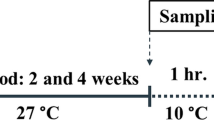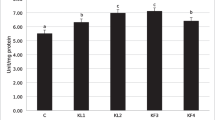Abstract
A serial of salinity transferring treatments were performed to investigate the osmoregulation of tongue sole (Cynoglossus semilaevis). Juvenile tongue sole were directly transferred from a salinity of 30 to 0, 10, 20, 30, 40 and 50. Blood sampling was performed for each treatment after 0, 1, 6 and 12 h, as well as after 1, 2, 4, 8, 16 and 32 d. The plasma osmolality, cortisol and free amino acids were assessed. Under the experimental conditions, no fish died after acute salinity transfer. The plasma cortisol level increased 1 h after the abrupt transfer from a salinity of 30 to that of 0, 40 and 50, and decreased from 6 h to 8 d after transfer. Similar trends were observed in the changes of plasma osmolality. The plasma free amino acids concentration showed a ‘U-shaped’ relationship with salinity after being transferred to different salinities for 4 days. More obvious changes of plasma free amino acid concentration occurred under hyper-osmotic conditions than under hypo-osmotic conditions. The concentrations of valine, isoleucine, lysine, glutamic acid, glycine, proline and taurine increased with rising salinity. The plasma levels of threonine, leucine, arginine, serine, and alanine showed a ‘U-shaped’ relationship with salinity. The results of this study suggested that free amino acids might have important effects on osmotic acclimation in tongue sole.
Similar content being viewed by others
References
Arjona, F. J., Vargas-Chacoff, L., Ruiz-Jarabo, I., Martín del Río, M. P., and Mancera, J. M., 2007. Osmoregulatory response of Senegalese sole (Solea senegalensis) to changes in environmental salinity. Comparative Biochemistry and Physiology-part A, 148 (2): 413–421.
Auerswald, L., Jürss, K., Schiedek, D., and Bastrop, R., 1997. The influence of salinity acclimation on free amino acids and enzyme activities in the intestinal mucosa of rainbow trout, Oncorhynchus mykiss (Walbaum). Comparative Biochemistry and Physiology–Part A, 116 (2): 149–155.
Ballantyne, J. S., 2001. Amino acid metabolism. In: Fish Physiology, Vol. 20 Nitrogen Excretion. Wright, P. A., and Anderson, A. J., eds., Academic Press, New York, 77–107.
Boeuf, G., and Payan, P., 2001. How should salinity influence fish growth? Comparative Biochemistry and Physiology–Part C, 130 (4): 411–423.
Bradford, M. M., 1976. A rapid and sensitive method for the quantification of microgram quantities of protein utilizing the principle of protein-dye binding. Analytical Biochemistry, 72 (1-2): 218–254.
Bystriansky, J. S., Frick, N. T., and Ballantyne, J. S., 2007. Intermediary metabolism of Arctic char Salvelinus alpinus during short-term salinity exposure. The Journal of Experimental Biology, 210 (Pt 11): 1971–1985.
Fauconneau, B., and Arnal, M., 1985. Leucine metabolism in trout (Salmo gairdneri Richardson.). Influence of temperature. Comparative Biochemistry and Physiology–Part A, 82 (2): 435–445.
Gilles, R., 1997. ‘Compensatory’ organic osmolytes in high osmolarity and dehydration stresses: History and perspectives. Comparative Biochemistry and Physiology–Part A, 117 (3): 279–290.
Gonzalez, R. J., 2012. The physiology of hyper-salinity tolerance in teleost fish: A review. Journal of Comparative Physiology B, 182 (3): 321–329.
Huxtable, R. J., 1992. Physiological actions of taurine. Physiological Reviews, 72 (1): 101–144.
Jamil, K., Shoaib, M., Ameer, F., and Lin, H., 2004. Salinity tolerance and growth response of juvenile Oreochaomis mossambicus at different salinity levels. Journal of Ocean Univerity of China, 3 (1): 53–55.
Jarvis, P. L., and Ballantyne, J. S., 2003. Metabolic responses to salinity acclimation in juvenile shortnose sturgeon Acipenser brevirostrum. Aquaculture, 219 (1-4): 891–909.
Jürss, K., Bittorf, T., Vökler, T., and Wacke, R., 1983. Influence of nutrition on biochemical sea water adaptation of the rainbow trout (Salmo gairdneri Richardson). Comparative Biochemistry and Physiology–Part B, 75 (4): 713–717.
Ma, A. J., Liu, X. Z., Xu, Y. J., Liang, Y., Zhuang, Z. M., Zhai, J. M., and Li, B., 2005. Study on feeding behavior and growth of tongue sole Cynoglossus semilaevis in early development stage. Oceanologia et Limnologia Sinica, 36 (2): 130–138.
Ma, A. J., Wang, X. A., Zhuang, Z. M., and Liu, X. Z., 2007. Study on relationship of the special sense organ and feeding behaviour of Cynoglossus semilaevis Güther. Oceanologia et Limnologia Sinica, 38 (3): 240–245.
McCormick, S. D., 2001. Endocrine control of osmoregulation in teleost fish. American Zoologist, 41: 781–794
Mommsen, T. P., Vijayan, M., and Moon, T., 1999. Cortisol in teleosts: Dynamics, mechanisms of action, and metabolic regulation. Reviews in Fish Biology and Fisheries, 9 (3): 211–268.
Obled, C., Papet, I., and Breuillee, D., 2002. Metabolic bases of amino acid requirements in acute diseases. Current Opinion in Clinical Nutrition & Metabolic Care, 5: 189–197.
O’Connor, E. A., Pottinger, T. G., and Sneddon, L. U., 2011. The effects of acute and chronic hypoxia on cortisol, glucose and lactate concentrations in different populations of three-spined stickleback. Fish Physiology and Biochemistry, 37 (3): 461–469.
Pankhurst, N. W., 2011. The endocrinology of stress in fish: An environmental perspective. General and Comparative Endocrinology, 170 (2): 265–275.
Powell, E. N., Kasschau, M., Chen, E., Koenig, M., and Pecon, J., 1982. Changes in the free amino acid pool during environmental stress in the gill tissue of the oyster, Crassostrea virginica. Comparative Biochemistry and Physiology–Part A, 71 (4): 591–598.
Robinson, J. W., Yanke, D., Mirza, J., and Ballantyne, J. S., 2011. Plasma free amino acid kinetics in tainbow trout (Oncorhynchus mykiss) using a bolus injection of 15N-labeled amino acids. Amino Acids, 40 (2): 689–696.
Sadok, S., M’Hetli, M., Abed, A., and Uglow, R. F., 2004. Changes in some nitrogenous compounds in the blood and tissues of freshwater pikeperch (Sander lucioperca) during salinity acclimation. Comparative Biochemistry and Physiology-part A, 138 (1): 9–15.
Sangiao-Alcarellos, S., Arjona, F. J., MartínRío, M. P., Míguez, J. M., Mancera, J. M., and Soengas, J. L., 2005. Time course of osmoregulatory and metabolic changes during osmotic acclimation in Sparus auratus. The Journal of Experimental Biology, 208 (Pt 22): 4291–4304.
Schaarschmidt, T., Meyer, E., and Jürss, K., 1999. A comparison of transport related gill enzyme activities and tissue-specific free amino acid concentrations of Baltic Sea (brackish water) and freshwater three spine sticklebacks, Gasterosteus aculeatus, after salinity and temperature acclimation. Marine Biology, 135 (4): 689–697.
Soengas, J. L., and Aldegunde, M., 2002. Energy metabolism of fish brain. Comparative Biochemistry and Physiology–Part B, 131 (3): 271–296.
Tseng, Y. C., and Hwang, P. P., 2008. Some insights into energy metabolism for osmoregulation in fish. Comparative Biochemistry and Physiology–Part C, 148 (4): 419–429.
Tian, X. L., Wang, G. D., and Dong, S. L., 2011. Effect of salinity on plasma osmolality and gill Na+/K+-ATPase activity of the tongue sole (Cynoglossus semilaevis). Marine Science, 35 (2): 27–31.
Vijayan, M. M., Pereira, C., Gordon, G. E., and Iwama, G. K., 1997. Metabolic response associated with confinement stress in tilapia: The role of cortisol. Comparative Biochemistry and Physiology–Part C, 116 (1): 89–95.
Webb, S. D., Woodcock, S. H., and Gillanders, B. M., 2012. Sources of otolith barium and strontium in estuarine fish and the influence of salinity and temperature. Marine Ecology, 453: 189–199.
Wen, H. S., Song, H. X., Yang, L. T., Mao, X. K., and Gao, L., 2006. A study on the effects of exogenous hormone on the plasma testosterone and estradiol levels in cultured Japanese flounder. Acta Oceanologica Sinica, 28 (4): 115–120.
Wilson, R. P., 2002. Amino acids and proteins. In: Fish Nutrition. Halver, J. E., and Hardy, R.W., eds., Elsevier Science, San Diego, 144–179.
Yamashita, Y., Tominaga, O., Takami, H., and Yamada, H., 2003. Comparison of growth, feeding and cortisol level in Platichthys bicoloratus juveniles between estuarine and nearshore nursery grounds. Journal of Fish Biology, 63 (3): 617–630.
Author information
Authors and Affiliations
Corresponding author
Rights and permissions
About this article
Cite this article
Wang, G., Xu, K., Tian, X. et al. Changes in plasma osmolality, cortisol and amino acid levels of tongue sole (Cynoglossus semilaevis) at different salinities. J. Ocean Univ. China 14, 881–887 (2015). https://doi.org/10.1007/s11802-015-2598-9
Received:
Revised:
Accepted:
Published:
Issue Date:
DOI: https://doi.org/10.1007/s11802-015-2598-9




